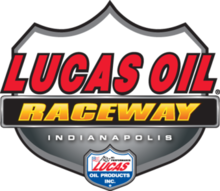Indianapolis Raceway Park
 
|
|
| Location | Brownsburg, Indiana |
|---|---|
| Time zone | GMT-5 |
| Capacity | 30,000 |
| Owner | National Hot Rod Association |
| Operator | National Hot Rod Association |
| Major events |
United States Auto Club National Hot Rod Association |
| Oval | |
| Surface | Asphalt |
| Length | 0.686 mi (1.1 km) |
| Turns | 4 |
| Banking | 12° |
| Lap record | 0:19.581 (Mark Smith, Ralt of America, 1989, Formula Super Vee) |
| Dragstrip | |
| Surface | Asphalt |
| Lap record | 0:4.486 (Tony Schumacher, Don Schumacher Racing, 2006, NHRA Top Fuel) |
| Road Course | |
| Surface | Asphalt |
| Length | 2.5 mi (4.0 km) |
| Turns | 15 |
| Lap record | 1:24.771 (Larry Connor, Ralt RT41, 2000, Formula Atlantic) |
Lucas Oil Raceway (formerly Indianapolis Raceway Park and O'Reilly Raceway Park at Indianapolis) is a drag racing track. The complex in Brownsburg, Indiana, also has a 0.686-mile (1.104 km) oval, 2.5-mile (4.0 km) road course. The 4,400-foot (1,300 m) drag strip is among the main drag racing venues in the world.
In 1958, 15 Indianapolis-area businessmen and racing professionals led by Tom Binford, Frank Dickie, Rodger Ward, and Howard Fieber, invested $5,000 each to fund the development of a 267-acre (108 ha) farm tract into a recreational sporting complex that would focus on auto racing. The original intention was to create a 15-turn, 2.5-mile (4.0 km) road course, but as an insurance measure against economic problems, the investment group decided to incorporate a quarter-mile drag strip into the long straightaway of the 2.5-mile (4.0 km) road course design. Constructed with assistance from the NHRA, the drag strip was the first to be completed, with the facility's first event held on the strip in the fall of 1960. The facility was called Indianapolis Raceway Park. A year later, a 0.686-mile (1.104 km) paved oval was completed to finish off the track capabilities of the facility. The oval track was used as-is until an overall track renovation was completed in 1988 in order to increase speed on the track.
The premier feature of the facility is a 4,400-foot (1,300 m) long dragstrip. The one NHRA event held at Raceway Park is the oldest and most prestigious race in the NHRA. The NHRA U.S. Nationals, held every year during the Labor Day weekend, is the only event on the NHRA schedule with final eliminations scheduled on a Monday. An all-star style race, called the Traxxas Nitro Shootout, is held for the two nitro divisions (Top Fuel on Saturday and Funny Car on Sunday). The winners in each division win $100,000 US, while the race itself has the largest purse of any NHRA sanctioned event at over $250,000 US. The drag strip has held the event every year since 1961, when the race was moved from Detroit.
USAC Silver Crown, Sprint Car and Midget Car races are held on the oval, along with other events suited to a shorter track. Raceway Park also traditionally stages an extensive program on the Saturday nights of major races at the Indianapolis Motor Speedway, with the Saturday night of Memorial Day weekend USAC Midget race called the "Night before the 500". The event is held the night before the Indianapolis 500 event at IMS, serving as something of an unofficial preliminary event to the far more famous one. Similarly, the NASCAR Kroger 200 was given a "Night before the 400" status. When Formula One raced at IMS, midget, sprint, and stock car races were held at ORP in the "Night Before F1" meets, including the 2002 and 2003 USGP races that featured a twin 25-lap midget format, with a full inversion, and the winner winning $50,000 if they could win both features.
...
Wikipedia
